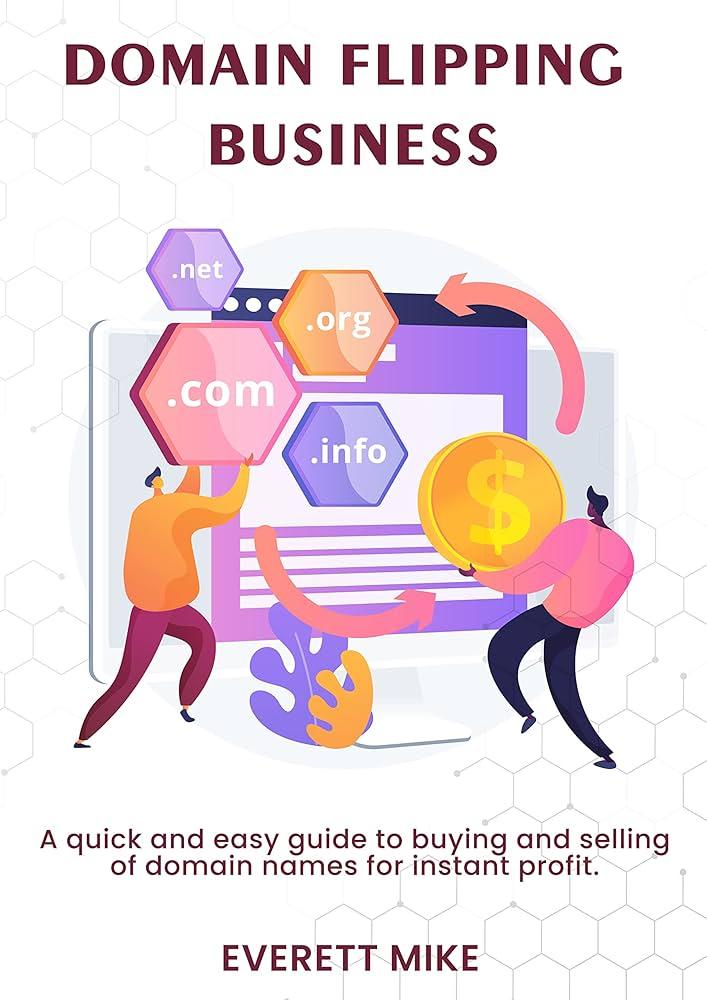Table of Contents
- Understanding the Basics of Domain Flipping
- Identifying High-Value Domains for Investment
- Mastering the Art of Domain Valuation
- Effective Strategies for Selling Your Domains
- Building a Strong Online Presence for Your Domain Portfolio
- Q&A
- Concluding Remarks


Understanding the Basics of Domain Flipping
Domain flipping is an intriguing venture that involves purchasing domain names at a low price and selling them at a premium. To get started, it’s vital to grasp several key concepts surrounding the domain marketplace. First, thorough research is essential to identify trending keywords and niches that have potential value. This can help inform your purchasing decisions and enable you to select domains with characteristics that make them sought after, such as brevity, relevance, and memorability.
Another crucial factor in domain flipping is the understanding of domain valuation. Several elements contribute to how much a domain can be worth, including its age, extension (like .com, .net, or .org), keyword popularity, and market demand. Assessing these aspects can help you make informed investments. Here are some aspects that influence domain value:
- Length: Shorter domains tend to be more valuable.
- Keywords: Domains containing popular search terms have higher appeal.
- Extension: .com domains are generally more valuable.
Once you acquire valuable domains, the next step is to market them effectively. Creating an attractive listing with detailed descriptions and using platforms like Flippa or Sedo can significantly boost your chances of a profitable flip. Additionally, networking with industry professionals through forums or social media groups can enhance your visibility within the market. Here is a simple comparison of popular domain-selling platforms:
| Platform | Features | Fees |
|---|---|---|
| Flippa | User-friendly interface, auction-style listings | Varies based on sale price |
| Sedo | Global reach, domain brokerage available | 10-15% commission |
| GoDaddy Auctions | Strong brand recognition, vast audience | $4.99 listing fee |
Identifying High-Value Domains for Investment
When venturing into domain flipping, one of the most critical steps is pinpointing domains that hold significant value. First, consider the length of the domain; shorter names are generally easier to remember and type, which makes them more desirable. Additionally, look for domains that are keyword-rich. A name that includes popular search terms can attract organic traffic and boost its marketability. Evaluate the extension as well; .com domains typically hold greater value due to their widespread recognition.
Another essential factor is age. Older domains often carry more authority in the eyes of search engines, which can significantly impact their resale value. Conduct research to find domains with a history of traffic, as these can provide a solid foundation for future profits. Explore the site’s backlink profile using tools like Ahrefs or Moz to determine how many reputable sites link back to your target domain. A strong backlink profile can indicate intrinsic value and help you estimate potential ROI.
Lastly, it’s crucial to stay updated on the trends within your niche. Invest in domains that align with current and future market demands. Here are some indicators that can help you identify worthwhile investments:
- Emerging technologies: Look for domains related to AI, blockchain, or other tech trends.
- Local marketplaces: Domains with geographic indications can attract local businesses.
- Trending topics: Keep an eye on social media and news outlets for popular themes.
By focusing on these areas, you can significantly enhance your ability to identify high-value domains that will pay off in the long run.


Mastering the Art of Domain Valuation
When diving into the world of domain flipping, understanding how to assess the value of a domain name is crucial for success. Several factors contribute to a domain’s value, making it essential to consider each one carefully. Here are some key elements to keep in mind:
- Length: Shorter domains are generally more desirable as they are easier to remember and type.
- Brandability: A domain that resonates with a specific niche or audience tends to command a higher price.
- Keywords: Domains with relevant keywords can improve SEO performance, making them more valuable.
- Extensions: While .com domains are typically the most sought after, other extensions like .net, .org, and newer options can also be valuable depending on the context.
To put these elements into perspective, a simple evaluation table can highlight how different factors play a role in determining domain value:
| Domain Feature | Value Contribution |
|---|---|
| Short Length | High Value |
| Brandable Name | Medium to High Value |
| SEO Keywords | Medium Value |
| Popular Extensions | High Value |
Ultimately, mastering domain valuation requires a blend of intuition, research, and understanding market trends. Regularly monitoring sales data on platforms like Sedo, GoDaddy, or Flippa can provide insights into what buyers are currently willing to pay. Additionally, engaging with communities, such as forums and social media groups dedicated to domain flipping, can offer valuable perspectives and emerging trends that may influence valuation. By synthesizing your findings and aligning them with your own strategic goals, you will be able to navigate the domain flipping landscape more effectively and confidently.


Effective Strategies for Selling Your Domains
When it comes to maximizing the value of your domain sales, having a solid marketing strategy is essential. Start by creating an appealing landing page for each domain. This page should clearly communicate the uniqueness and potential of the domain, including relevant keywords that make it easily discoverable to buyers. Consider incorporating eye-catching visuals and testimonials, if available, to build credibility. Highlighting the domain’s SEO potential, for instance, can attract business owners looking to enhance their online presence.
Networking within online communities can also be a game-changer. Engage with other domain traders through forums, social media, and professional networks. Participate in discussions, share insights, and establish your reputation as a knowledgeable seller. Additionally, it’s beneficial to list your domains on multiple platforms or marketplaces, such as:
- Sedo – Offers a wide audience of potential buyers.
- Flippa – Known for domains and websites, with various bidding options.
- GoDaddy Auctions - One of the largest auction platforms with massive traffic.
Understanding the right price point is another critical element of successful domain flipping. Consider conducting market research to determine what similar domains are selling for, taking into account factors such as length, keywords, and the overall market trends. A simple comparison table can clarify your pricing strategies:
| Domain Category | Average Selling Price | Features to Highlight |
|---|---|---|
| Short Domains | $5,000+ | Brandability, memorability |
| Keyword-Rich Domains | $2,000 – $10,000 | SEO value, niche target |
| Premium Domains | $10,000+ | High traffic potential, industry authority |
By strategically promoting your domains, actively networking, and accurately pricing your offerings, you can significantly improve your chances of profitable sales in the domain flipping market.


Building a Strong Online Presence for Your Domain Portfolio
Creating a robust online presence for your portfolio of domains is essential for standing out in the competitive world of domain flipping. Start by developing a professional website that showcases your portfolio. Ensure your site is not only visually appealing but also user-friendly, allowing potential buyers to easily navigate through the selection of domains. Include a bio and testimonials to build trust and credibility, while also emphasizing the potential value each domain offers.
Utilizing various platforms can enhance your visibility. Consider engaging on online marketplaces dedicated to domain sales, such as Flippa and Sedo. Social media channels like Twitter, Instagram, and LinkedIn can also serve as effective tools. Share insights, market trends, and industry news to position yourself as an authority in the domain flipping niche. Be consistent in your branding across all platforms to foster recognition and reliability.
Search Engine Optimization (SEO) plays a critical role in driving organic traffic to your domain listings. Implementing relevant keywords related to domain flipping and utilizing well-crafted meta descriptions can significantly improve your search visibility. Here’s a simple table to illustrate important on-page SEO elements:
| SEO Element | Best Practices |
|---|---|
| Title Tag | Include primary keywords, keep it under 60 characters. |
| Meta Description | Summarize the page using target keywords, aiming for 150-160 characters. |
| Image Alt Text | Describe the image using relevant keywords to improve image search ranking. |
| Header Tags | Utilize H1, H2, and H3 for structuring content hierarchically. |
Q&A
Q&A: Learning Domain Flipping
What is domain flipping?
Domain flipping is the practice of buying domain names at a low price and selling them at a higher price. Essentially, it’s a way to invest in digital real estate. Just as you would purchase a house with the intent to sell it for a profit, domain flipping involves acquiring web addresses that you believe will appreciate in value over time.How does one start with domain flipping?
To start domain flipping, you’ll need to follow these steps:- Research: Begin by learning about current market trends and demands in domain names. Explore what types of domains are selling well, such as keyword-rich names, brandable names, or those with geographic significance.
- Select a niche: Specializing in a particular niche can give you an edge. Whether it’s technology, fashion, or health, focus on finding domains related to your chosen interest.
- Register domains: Use domain registrars to purchase domain names that are available. You can often find unique and unregistered names through brainstorming or utilizing keyword tools.
- Build a portfolio: Accumulate a diverse portfolio of domains. Aim for a variety of TLDs (Top-Level Domains) and styles, balancing between short, memorable names and longer, descriptive ones.
- List for sale: Use platforms like GoDaddy, Flippa, or Afternic to list your domains for sale. Make sure your listings are appealing and optimized with relevant keywords.
What makes a good domain name?
A good domain name is typically:- Short and Memorable: The easier it is to remember, the better it will sell.
- Descriptive: It should give potential buyers an idea of what the site could be about.
- Relevant: Align with current trends or keywords that people are searching for.
- Brandable: Potential buyers should see it as something they can easily brand.
How much can you earn from flipping domains?
Earnings vary significantly in domain flipping. Some individuals might earn a few hundred dollars with their first sale, while others can rake in thousands, especially for premium domains. The key is to research effectively, invest wisely, and market your domains skillfully.What are the risks associated with domain flipping?
Like any investment, domain flipping carries risks. It’s possible you may not sell a domain or that its resale value can depreciate due to market demand fluctuations. Additionally, the competition is fierce, and not all domains will yield a profit.How do I determine the value of a domain?
To determine the value of a domain, consider:- Length: Shorter names are typically more valuable.
- Keywords: If it contains popular keywords, it can have higher value.
- TLD: Domains ending in “.com” tend to be more sought-after.
- Market demand: Look at similar sales and trends in the industry to gauge worth.

